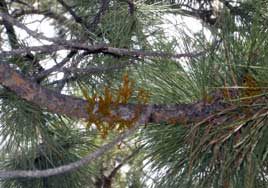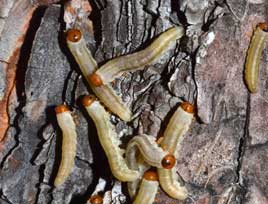Franktown Field Office – Insects & Diseases
Insects and diseases can pose serious threats to a forest’s health. Our foresters monitor insect and disease activity and trends, and respond to emerging threats to our communities’ forests.
Common Insect & Disease Concerns
As soon as you notice any abnormality in your tree’s appearance, you must begin careful analysis to gain an understanding of the problem. By examining the specific symptoms of damage and understanding their causes, you can make a reasonable diagnosis of the problem and select the proper treatment using this guide to Systematic Plant Evaluation.
If your questions cannot be resolved with the information provided in the guide or the links below, please contact the Franktown Field Office at (303) 660-9625.
Foresters are available to conduct site visits to look at specific insect or disease concerns on your property. These visits are by appointment only, and have an associated service fee. To schedule an appointment please call the Franktown Field Office.
Common Local Insects & Diseases
Ponderosa Pine


- Dwarf Mistletoe Management
- Ips Bark Beetles
- Mountain Pine Beetle
- Pine Sawfly (3 MB PDF)
- May 2015 Report: Potential for Pine Sawfly Defoliation of Ponderosa Pine, Elbert County
- Nov 2014: Pine Sawfly Meeting Presentation: Bill Ciesla
- Oct 2014: Forestry Experts to Discuss Pine Sawfly Outbreak
- July 2014 Report: Pine Sawfly Report: An Outbreak in Elbert County, Colorado
- July 2014 News: Pine Sawfly Outbreak Emerges in Ponderosa Pine Forests of Elbert, El Paso Counties
- USFS Fact Sheet: Diprionid Sawflies on Lodgepole & Ponderosa Pines (1.3 MB PDF)
- Ponderosa Pine Needle Miners
- Red Turpentine Beetle (2 MB PDF)
- Zimmerman Pine Tip Moth (3 MB PDF)
Douglas-fir
- Douglas-fir Beetle – 2016 Quick Guide (561 KB PDF)
- Douglas-fir Tussock Moth Treatment Options (8.9 MB PDF)
- Douglas-fir Tussock Moth – 2015 Quick Guide (5.4 MB PDF)
- Oct 2015: Douglas-fir Tussock Moth Information Meeting: Presentations in Castle Rock
- Western Balsam Bark Beetle
Aspen
- Aspen and Popular Leaf Spots (2.6 MB PDF)
- Cytospora Canker (1.4 MB PDF)
- Oystershell Scale (2.5 MB PDF)
- Poplar Twiggall Fly (2.2 MB PDF)
Gambel Oak
- Fall Cankerworm (731 KB PDF)
Other Insects of Concern
- Emerald Ash Borer (6 MB PDF)
Other Damage
There are non-insect and disease-related factors that affect trees and create signs/symptoms that can be confused with insect and disease activities. Below are common disorders/damage that affect conifers on the district:
- Environmental Disorders of Woody Plants (122 KB PDF)
- Magnesium Chloride Toxicity in Trees (2.8 MB PDF)
The Annual Report on the Health of Colorado’s Forests provides an overview of insect and disease conditions in all of the state’s forests.
Forest Insect & Disease Aerial Survey
The annual survey is led, coordinated and funded by the U.S. Forest Service. A small fixed-wing aircraft is flown between 1,000 to 1,500 feet above the treetops while surveyors mark on a map the location, number and identity of trees affected by insects or diseases. The CSFS has assisted in the aerial survey since the 1970s and began playing a larger role in 1997.
For more information about the state aerial survey, visit U.S. Forest Service Rocky Mountain Region.

